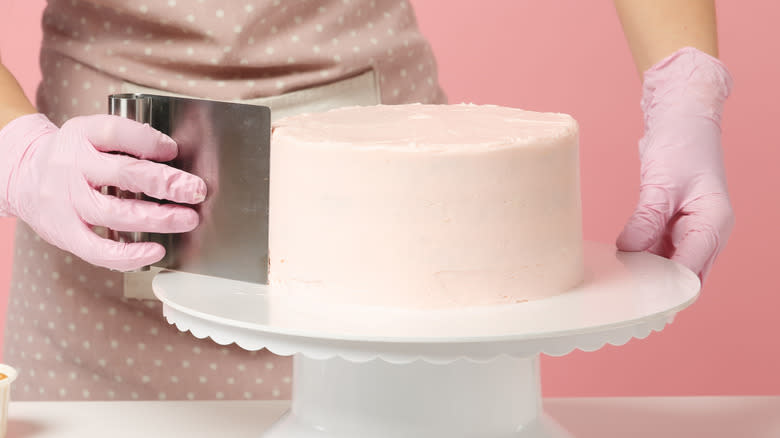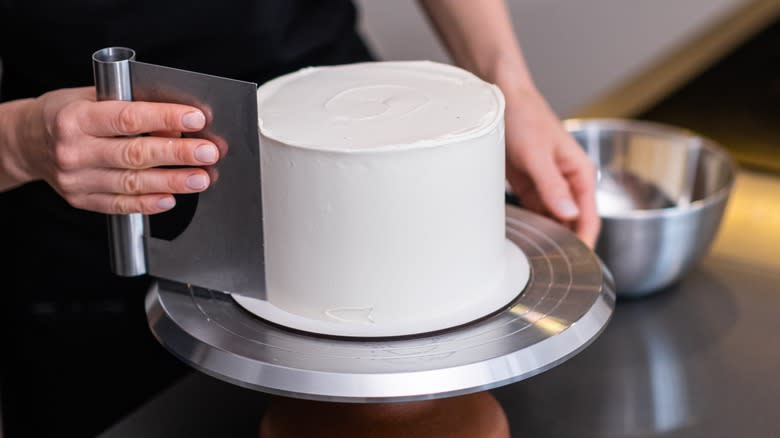A Cake Comb Is The Ultimate Tool For More Beautiful Buttercream

No matter what way you look at it, coming up with easy yet creative ways to decorate a cake is tough. You might have a beautiful idea in your head of how the dessert will turn out, only to have it wind up looking more like something off "Nailed It" than the "Great British Bake Off." Now, there's one easy way to decorate your desserts and give them a beautiful finish without having to mess about with piping bags or fondant. All you need is something called a cake comb.
Cake combs are flat tools that are used to apply texture or simply smooth out the icing on your cake, giving it a uniform outer appearance and a clean look. To use them, just apply your buttercream frosting (or any other type, such as cream cheese, if you'd prefer) to your cake, then hold the cake comb against the sides or top of your cake as you turn it to flatten and smooth the frosting. Just like that, you'll have a cake that's far more pristine-looking than if you'd used a spatula, and easier to decorate than if you'd piped the frosting on.
Read more: Cake Hacks Every Baker Will Wish They Knew Sooner
Different Types Of Cake Combs

As you can probably imagine, not all cake combs are the same. For starters, they can be made out of different materials. Typically, they're made of metal, acrylic, or plastic. All of them work the same way, but plastic and acrylic are more prone to nicks, which can wind up affecting the smoothness of your frosting. So, metal may be the best choice for ensuring a smooth and uniform frosting.
Beyond the material, you'll also find them in different sizes and shapes. You can find them in rectangles or squares as well as dome shapes, where the flat side is used to smooth your frosting. Some also have grips on them to make them easier to hold onto. Plus, they come in varying heights, suited to different-sized cakes, whether that's a one-tier dessert or a fancy multi-level one.
Finally, cake combs also have varying edges. Some of them have flat edges, which create a smooth outer layer, while others have teeth in the shape of squares, domes, triangles, and other patterns. When you use toothed combs, they create a texture on the exterior of your dessert, giving it a unique edge. You may even find cake combs with different types of teeth on each side! The world of cake combs is vast, so if you want to use one of these easy tools, you have plenty of options to choose from to create beautiful desserts.
Tips And Tricks For Using Cake Combs

While using a cake comb is fairly straightforward, there are still tips to keep in mind as you work to ensure you have a beautiful outer layer of frosting. For starters, you'll want to make sure your cake is completely cool before beginning to ice it. This prevents you from getting a melty, gooey mess. You'll also want to apply a base crumb coat and let that set in the fridge. Then, when you apply the outer layer of frosting, it pays to apply a thick layer of buttercream or other icing to the treat. All these steps help you avoid your comb creating a crumby mess by pulling cake bits off as you swipe.
Another trick to keep in mind is to use a firmer frosting and press firmly into the frosting as you use your scraper. A harder frosting better maintains its shape, while pressing firmly creates crisper lines when using a patterned comb. The result is a treat that beautifully shows off the lines left by your cake comb.
Finally, as you work, don't forget to wipe your comb off whenever too much frosting starts to build up. This helps keep it clean and ensures you get a smooth finish or well-defined lines and patterns. It also prevents the icing from hardening on your comb and affecting the design you're making. With these tips and tricks, you're ready to get decorating in a neat new way!
Read the original article on Daily Meal.

